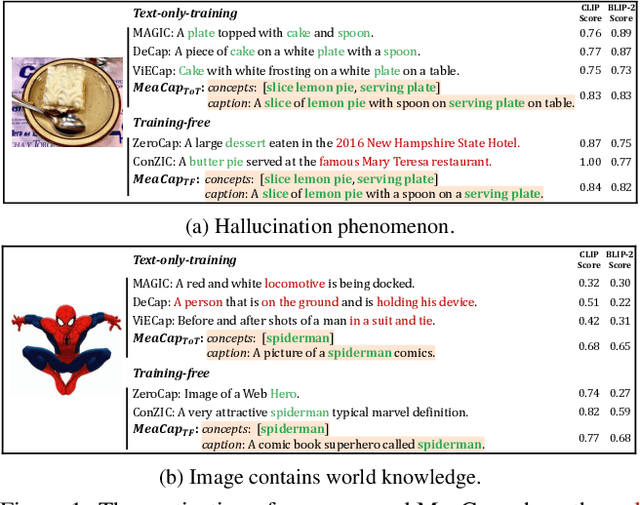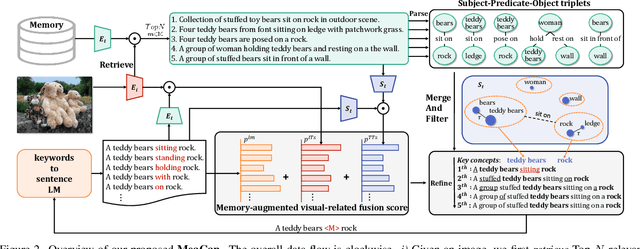Yan Xie
AFD-SLU: Adaptive Feature Distillation for Spoken Language Understanding
Sep 05, 2025Abstract:Spoken Language Understanding (SLU) is a core component of conversational systems, enabling machines to interpret user utterances. Despite its importance, developing effective SLU systems remains challenging due to the scarcity of labeled training data and the computational burden of deploying Large Language Models (LLMs) in real-world applications. To further alleviate these issues, we propose an Adaptive Feature Distillation framework that transfers rich semantic representations from a General Text Embeddings (GTE)-based teacher model to a lightweight student model. Our method introduces a dynamic adapter equipped with a Residual Projection Neural Network (RPNN) to align heterogeneous feature spaces, and a Dynamic Distillation Coefficient (DDC) that adaptively modulates the distillation strength based on real-time feedback from intent and slot prediction performance. Experiments on the Chinese profile-based ProSLU benchmark demonstrate that AFD-SLU achieves state-of-the-art results, with 95.67% intent accuracy, 92.02% slot F1 score, and 85.50% overall accuracy.
Breaking the Exploration Bottleneck: Rubric-Scaffolded Reinforcement Learning for General LLM Reasoning
Aug 23, 2025Abstract:Recent advances in Large Language Models (LLMs) have underscored the potential of Reinforcement Learning (RL) to facilitate the emergence of reasoning capabilities. Despite the encouraging results, a fundamental dilemma persists as RL improvement relies on learning from high-quality samples, yet the exploration for such samples remains bounded by the inherent limitations of LLMs. This, in effect, creates an undesirable cycle in which what cannot be explored cannot be learned. In this work, we propose Rubric-Scaffolded Reinforcement Learning (RuscaRL), a novel instructional scaffolding framework designed to break the exploration bottleneck for general LLM reasoning. Specifically, RuscaRL introduces checklist-style rubrics as (1) explicit scaffolding for exploration during rollout generation, where different rubrics are provided as external guidance within task instructions to steer diverse high-quality responses. This guidance is gradually decayed over time, encouraging the model to internalize the underlying reasoning patterns; (2) verifiable rewards for exploitation during model training, where we can obtain robust LLM-as-a-Judge scores using rubrics as references, enabling effective RL on general reasoning tasks. Extensive experiments demonstrate the superiority of the proposed RuscaRL across various benchmarks, effectively expanding reasoning boundaries under the best-of-N evaluation. Notably, RuscaRL significantly boosts Qwen-2.5-7B-Instruct from 23.6 to 50.3 on HealthBench-500, surpassing GPT-4.1. Furthermore, our fine-tuned variant on Qwen3-30B-A3B-Instruct achieves 61.1 on HealthBench-500, outperforming leading LLMs including OpenAI-o3.
A Scalable Pretraining Framework for Link Prediction with Efficient Adaptation
Aug 06, 2025



Abstract:Link Prediction (LP) is a critical task in graph machine learning. While Graph Neural Networks (GNNs) have significantly advanced LP performance recently, existing methods face key challenges including limited supervision from sparse connectivity, sensitivity to initialization, and poor generalization under distribution shifts. We explore pretraining as a solution to address these challenges. Unlike node classification, LP is inherently a pairwise task, which requires the integration of both node- and edge-level information. In this work, we present the first systematic study on the transferability of these distinct modules and propose a late fusion strategy to effectively combine their outputs for improved performance. To handle the diversity of pretraining data and avoid negative transfer, we introduce a Mixture-of-Experts (MoE) framework that captures distinct patterns in separate experts, facilitating seamless application of the pretrained model on diverse downstream datasets. For fast adaptation, we develop a parameter-efficient tuning strategy that allows the pretrained model to adapt to unseen datasets with minimal computational overhead. Experiments on 16 datasets across two domains demonstrate the effectiveness of our approach, achieving state-of-the-art performance on low-resource link prediction while obtaining competitive results compared to end-to-end trained methods, with over 10,000x lower computational overhead.
Higher-order Structure Boosts Link Prediction on Temporal Graphs
May 21, 2025Abstract:Temporal Graph Neural Networks (TGNNs) have gained growing attention for modeling and predicting structures in temporal graphs. However, existing TGNNs primarily focus on pairwise interactions while overlooking higher-order structures that are integral to link formation and evolution in real-world temporal graphs. Meanwhile, these models often suffer from efficiency bottlenecks, further limiting their expressive power. To tackle these challenges, we propose a Higher-order structure Temporal Graph Neural Network, which incorporates hypergraph representations into temporal graph learning. In particular, we develop an algorithm to identify the underlying higher-order structures, enhancing the model's ability to capture the group interactions. Furthermore, by aggregating multiple edge features into hyperedge representations, HTGN effectively reduces memory cost during training. We theoretically demonstrate the enhanced expressiveness of our approach and validate its effectiveness and efficiency through extensive experiments on various real-world temporal graphs. Experimental results show that HTGN achieves superior performance on dynamic link prediction while reducing memory costs by up to 50\% compared to existing methods.
Discovering Fine-Grained Visual-Concept Relations by Disentangled Optimal Transport Concept Bottleneck Models
May 12, 2025



Abstract:Concept Bottleneck Models (CBMs) try to make the decision-making process transparent by exploring an intermediate concept space between the input image and the output prediction. Existing CBMs just learn coarse-grained relations between the whole image and the concepts, less considering local image information, leading to two main drawbacks: i) they often produce spurious visual-concept relations, hence decreasing model reliability; and ii) though CBMs could explain the importance of every concept to the final prediction, it is still challenging to tell which visual region produces the prediction. To solve these problems, this paper proposes a Disentangled Optimal Transport CBM (DOT-CBM) framework to explore fine-grained visual-concept relations between local image patches and concepts. Specifically, we model the concept prediction process as a transportation problem between the patches and concepts, thereby achieving explicit fine-grained feature alignment. We also incorporate orthogonal projection losses within the modality to enhance local feature disentanglement. To further address the shortcut issues caused by statistical biases in the data, we utilize the visual saliency map and concept label statistics as transportation priors. Thus, DOT-CBM can visualize inversion heatmaps, provide more reliable concept predictions, and produce more accurate class predictions. Comprehensive experiments demonstrate that our proposed DOT-CBM achieves SOTA performance on several tasks, including image classification, local part detection and out-of-distribution generalization.
HICEScore: A Hierarchical Metric for Image Captioning Evaluation
Jul 26, 2024



Abstract:Image captioning evaluation metrics can be divided into two categories, reference-based metrics and reference-free metrics. However, reference-based approaches may struggle to evaluate descriptive captions with abundant visual details produced by advanced multimodal large language models, due to their heavy reliance on limited human-annotated references. In contrast, previous reference-free metrics have been proven effective via CLIP cross-modality similarity. Nonetheless, CLIP-based metrics, constrained by their solution of global image-text compatibility, often have a deficiency in detecting local textual hallucinations and are insensitive to small visual objects. Besides, their single-scale designs are unable to provide an interpretable evaluation process such as pinpointing the position of caption mistakes and identifying visual regions that have not been described. To move forward, we propose a novel reference-free metric for image captioning evaluation, dubbed Hierarchical Image Captioning Evaluation Score (HICE-S). By detecting local visual regions and textual phrases, HICE-S builds an interpretable hierarchical scoring mechanism, breaking through the barriers of the single-scale structure of existing reference-free metrics. Comprehensive experiments indicate that our proposed metric achieves the SOTA performance on several benchmarks, outperforming existing reference-free metrics like CLIP-S and PAC-S, and reference-based metrics like METEOR and CIDEr. Moreover, several case studies reveal that the assessment process of HICE-S on detailed captions closely resembles interpretable human judgments.Our code is available at https://github.com/joeyz0z/HICE.
A Scalable and Effective Alternative to Graph Transformers
Jun 17, 2024



Abstract:Graph Neural Networks (GNNs) have shown impressive performance in graph representation learning, but they face challenges in capturing long-range dependencies due to their limited expressive power. To address this, Graph Transformers (GTs) were introduced, utilizing self-attention mechanism to effectively model pairwise node relationships. Despite their advantages, GTs suffer from quadratic complexity w.r.t. the number of nodes in the graph, hindering their applicability to large graphs. In this work, we present Graph-Enhanced Contextual Operator (GECO), a scalable and effective alternative to GTs that leverages neighborhood propagation and global convolutions to effectively capture local and global dependencies in quasilinear time. Our study on synthetic datasets reveals that GECO reaches 169x speedup on a graph with 2M nodes w.r.t. optimized attention. Further evaluations on diverse range of benchmarks showcase that GECO scales to large graphs where traditional GTs often face memory and time limitations. Notably, GECO consistently achieves comparable or superior quality compared to baselines, improving the SOTA up to 4.5%, and offering a scalable and effective solution for large-scale graph learning.
Degree of Irrationality: Sentiment and Implied Volatility Surface
May 20, 2024Abstract:In this study, we constructed daily high-frequency sentiment data and used the VAR method to attempt to predict the next day's implied volatility surface. We utilized 630,000 text data entries from the East Money Stock Forum from 2014 to 2023 and employed deep learning methods such as BERT and LSTM to build daily market sentiment indicators. By applying FFT and EMD methods for sentiment decomposition, we found that high-frequency sentiment had a stronger correlation with at-the-money (ATM) options' implied volatility, while low-frequency sentiment was more strongly correlated with deep out-of-the-money (DOTM) options' implied volatility. Further analysis revealed that the shape of the implied volatility surface contains richer market sentiment information beyond just market panic. We demonstrated that incorporating this sentiment information can improve the accuracy of implied volatility surface predictions.
VCR-Graphormer: A Mini-batch Graph Transformer via Virtual Connections
Mar 24, 2024



Abstract:Graph transformer has been proven as an effective graph learning method for its adoption of attention mechanism that is capable of capturing expressive representations from complex topological and feature information of graphs. Graph transformer conventionally performs dense attention (or global attention) for every pair of nodes to learn node representation vectors, resulting in quadratic computational costs that are unaffordable for large-scale graph data. Therefore, mini-batch training for graph transformers is a promising direction, but limited samples in each mini-batch can not support effective dense attention to encode informative representations. Facing this bottleneck, (1) we start by assigning each node a token list that is sampled by personalized PageRank (PPR) and then apply standard multi-head self-attention only on this list to compute its node representations. This PPR tokenization method decouples model training from complex graph topological information and makes heavy feature engineering offline and independent, such that mini-batch training of graph transformers is possible by loading each node's token list in batches. We further prove this PPR tokenization is viable as a graph convolution network with a fixed polynomial filter and jumping knowledge. However, only using personalized PageRank may limit information carried by a token list, which could not support different graph inductive biases for model training. To this end, (2) we rewire graphs by introducing multiple types of virtual connections through structure- and content-based super nodes that enable PPR tokenization to encode local and global contexts, long-range interaction, and heterophilous information into each node's token list, and then formalize our Virtual Connection Ranking based Graph Transformer (VCR-Graphormer).
MeaCap: Memory-Augmented Zero-shot Image Captioning
Mar 06, 2024



Abstract:Zero-shot image captioning (IC) without well-paired image-text data can be divided into two categories, training-free and text-only-training. Generally, these two types of methods realize zero-shot IC by integrating pretrained vision-language models like CLIP for image-text similarity evaluation and a pre-trained language model (LM) for caption generation. The main difference between them is whether using a textual corpus to train the LM. Though achieving attractive performance w.r.t. some metrics, existing methods often exhibit some common drawbacks. Training-free methods tend to produce hallucinations, while text-only-training often lose generalization capability. To move forward, in this paper, we propose a novel Memory-Augmented zero-shot image Captioning framework (MeaCap). Specifically, equipped with a textual memory, we introduce a retrieve-then-filter module to get key concepts that are highly related to the image. By deploying our proposed memory-augmented visual-related fusion score in a keywords-to-sentence LM, MeaCap can generate concept-centered captions that keep high consistency with the image with fewer hallucinations and more world-knowledge. The framework of MeaCap achieves the state-of-the-art performance on a series of zero-shot IC settings. Our code is available at https://github.com/joeyz0z/MeaCap.
 Add to Chrome
Add to Chrome Add to Firefox
Add to Firefox Add to Edge
Add to Edge